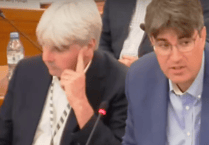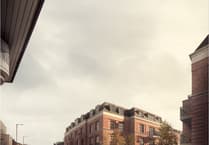IN July last year the Farnham Neighbourhood Plan - setting out a community-led blueprint for development in the town up to 2031 - was adopted on the back of five years of public workshops, consultations, a referendum backed by 88 per cent of voters and a hard-fought victory over a consortium of developers in the High Court.
But as reported in the Herald, just over six months later Farnham’s plan is now facing an early review to find sites for another 450 homes on top of the 2,330 already identified, after a government inspector endorsed modifications to Waverley Borough Council’s own draft Local Plan.
These include allocating the lion’s share of an imposed uplift in housing to Farnham, and not a single additional home at Waverley’s largest brownfield site Dunsfold Park, effectively sending Farnham’s own Neighbourhood Plan back to the drawing board and raising fears that it could leave the door ajar for speculative development.
This was greeted with dismay by the leader of Farnham Town Council and architect of the town plan, Carole Cockburn, as a “cruel blow” to both Farnham and Localism - and this week the Herald asked a selection of the countless individuals, societies, organisations, businesses and residents associations instrumental in the development of the Farnham Neighbourhood Plan to also share their thoughts on the inspector’s decision.
• David Howell, chairman of the Farnham Society planning committee.
“The issue really is why did Waverley fail the residents of the borough so badly?”.
“Waverley has had two previous failed attempts to have their Local Plan adopted and only achieved conditional approval now by accepting the inspector’s stipulated major modifications.
“Their failure has cost the borough dear, with developers exploiting Waverley’s failure by going to appeal on refused planning applications resulting in a number of unwanted housing developments. I also question Waverley’s assertion that they put up a robust defence at the [Local Plan] Examination in Public.
“I am deeply disappointed that Inspector Jonathan Bore has supported the allocation of 450 additional houses to Farnham, raising the total allocation from 2,330 to 2,780, and agreed that no additional houses are to be allocated to Dunsfold.
“It makes no sense that the location of these additional houses must be decided in the next 18 months to two years despite insufficient availability of Suitable Alternative Natural Greenspace (SANG) to mitigate against their construction.
“The SANG allocation of Farnham Park will be depleted by the current housing numbers. Waverley are now rushing this further housing allocation of 450 houses in Farnham unnecessarily.
“The additional housing will probably result in the loss of greenfield space around the town, where the majority of residents appreciate it most.
“I acknowledge that Farnham is the largest conurbation in the borough, but at the same time its infrastructure is creaking under the most strain and the town centre has the borough’s worst air quality.
“Also, what happens if in five years’ time a new brownfield housing development opportunity presents itself when Farnham has allocated sufficient housing using greenfield sites and there is no SANG available? The allocation of the additional housing should be delayed as argued until 2022 to 2025.”
• Zofia Lovell, chairman of the South Farnham Residents Association:
“Farnham’s Neighbourhood Plan was made over six months ago, with public consultation, referendum and overwhelming support, agreeing it would be reviewed a few years into the plan period, as sites came forward. The Neighbourhood Plan itself is not unsound and will remain part of the statutory development plan.
“Increased numbers suggested by the inspector amount to about 32 homes a year. We don’t have to come up with the total number all at once, just to give Waverley Borough Council a security blanket, for their Local Plan. New sites will come forward and fill the numbers, so what’s the rush?
“The Farnham appeal sites with the Secretary of State, will be judged only on the merits (or demerits) of the specific site. Not on misleading quotes, or in the context as potential sites just to fill the numbers now imposed by Waverley Borough Councils Local Plan.
“Waverley’s executive committee leader Julia Potts, a Farnham councillor, should support Localism and allow the town council and Farnham people, to do the work at local level, to find the land required.”
• Cliff Watts, chairman of the Badshot Lea Community Association:
“With regard to the Farnham Neighbourhood Plan, Inspector Bore says: ‘Planning is a continuous process, so whilst it is fully appreciated that a great deal of work has gone into producing the Neighbourhood Plan, the development plan will always need to evolve to reflect changing circumstances.’
“Between now and 2031 many things will change including governments, the economy, planning guidance, housing need and housing provision. So why do we have to find the additional sites now when we already have over 80 per cent of the total identified need and could clearly find the rest as the plan `evolves to reflect changing circumstances`?
“It appears that the residents of Farnham must accept the additional 450 homes but they should also be given time to decide where they go. Development should be plan-led, as per national guidance, and not done in a rush and dictated by random applications by speculative developers. Sadly in their desperate rush to adopt the Local Plan most of our Waverley councillors seem happy with this situation and are ominously quiet on all this.”
• Stewart Edge, a North West Farnham Residents Association committee member, but speaking on behalf of Farnham Liberals:
“The inspector’s report was very disappointing – accepting as it did Waverley Conservative’s proposal (in response to his requirement to build more houses) that Farnham should build on more green field land while the Dunsfold aerodrome site need not increase their 2,600 share.
“We think that the Inspector would have supported more than 2,600 at Dunsfold and fewer in Farnham if Waverley had suggested this. However, now that he has taken his decision we have to live with it and make the best of it.
“It is essential that Farnham Town Council rather than Waverley should decide where the additional houses should go; that we keep making the case for improved infrastructure such as road improvements to deal with the additional houses; and that we ensure that 30-plus per cent of the houses are affordable, with the majority of these for rent, rather than for purchase at prices many cannot afford.”

.png?width=209&height=140&crop=209:145,smart&quality=75)



Comments
This article has no comments yet. Be the first to leave a comment.